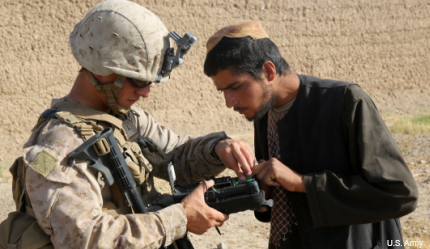DOD’s biometric terrorist ID upgrade ready for another close-up
Version 1.2 of ABIS, which proved lacking in tests last year, passes one round of tests and moves on to the next stage.

A Marine corporal uses ABIS 1.0 in Afghanistan earlier this year.
After a few fits and starts, an upgrade to the Defense Department’s biometric system for identifying terrorists, criminals, and other persons of interest has passed one round of tests and is ready for an operational test that will determine whether it’s fit for the field.
Version 1.2 of the Automated Biometric Identification System (ABIS) in March completed a customer test conducted by the Army Electronic Proving Ground that established its technical readiness, according to an announcement from DOD Biometrics’ project management office. The operational test will take place this fall to determine if ABIS 1.2 is ready for deployment.
ABIS, in Version 1.0, has been in use since 2009. U.S. forces in theater use it to gather biometric data—fingerprints, palm prints, iris and facial scans—that is linked to the FBI’s Integrated Automated Fingerprint Identification System (IAFIS) and the Homeland Security Department’s IDENT System as a way to identify potential terrorists or other adversaries. As of 2013, the system had made about 500,000 matches.
But the system is getting old, and DOD Biometrics had planned to replace it in August 2013 with Version 1.2, capable of processing 30,000 transactions a day—twice that of Version 1.0—and increase its storage capacity from 10 million records to 18 million.
Tests of the system, however, showed that it wasn’t ready for prime time. A report by DOD’s Office of the Director, Operational Test & Evaluation found a number of “high-priority deficiencies … that affected mission accomplishment due to deficiencies in the ABIS 1.2 baseline.”
With the results of this year’s customer tests—which included several military commands, the State Department, DHS, Customs and Border Patrol and the FBI—the upgraded system could be back on track. If it passes the operational test in the fall, DOD will begin phasing out Version 1.0 in favor of the new system.
“These capabilities are necessary tools for the warfighter and for our interagency partners to be able to deprive our enemies of anonymity,” Army Col. Sandy Vann-Olejasz, the project manager for DOD Biometrics, said in the agency’s announcement.
NEXT STORY: Air Force seeks new ICBM technologies



